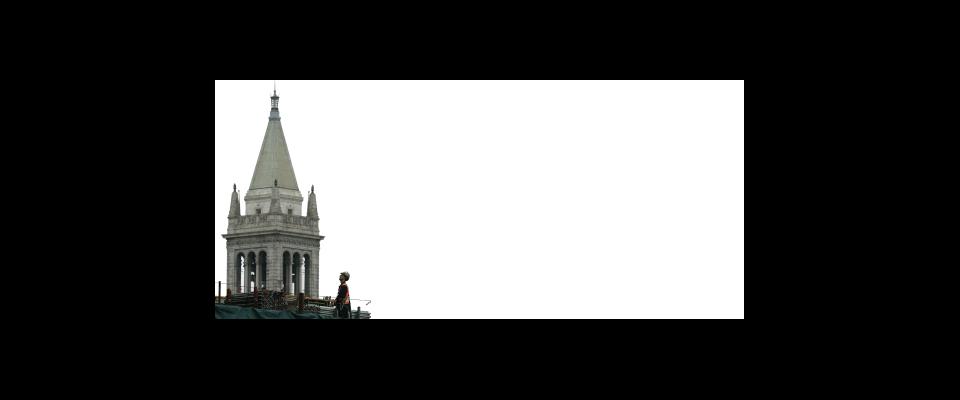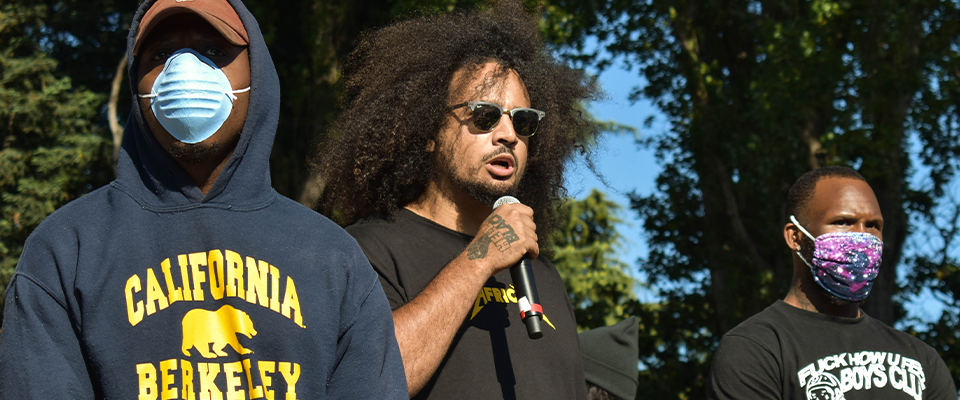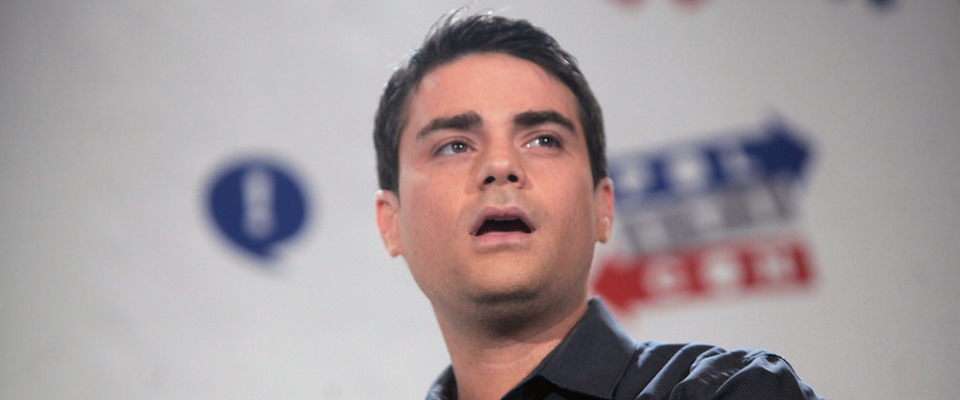In terms of demographics, funding, architecture, student culture, politics, you name it, Berkeley keeps changing.
For a quick dose of Cal cultural vertigo, imagine this: A modern Rip Van Winkle wakes, dumbfounded from a 40-year sleep in a hidden nook next to Strawberry Creek. The last thing he recalls was a fog of National Guard tear gas in 1969. But now, instead of the menacing wop-wop of military helicopters, he hears the dulcet doo-wop of a student a cappella group, the Golden Overtones, singing “In the Still of the Night” next to Sather Gate. Student tables and leaflets still abound, but they’re not for the Third World Liberation Front. More likely the Berkeley College Republicans, who claim to be the largest political group now on campus, or a Christian student association.
Most striking, perhaps, is the disappearance of a mostly male, mostly white student body. More than half the student population—swelled nearly 30 percent since fall 1969, to 35,409 in fall 2008—is female. The faculty, too, has experienced a significant shift, from only 1 in 20 being female in 1970, to 6 times that proportion today, about 30 percent.
For several years, it’s been reported that students of Asian origin have become the largest group among undergrads, and now it’s true for all students combined. By last fall, the Asian-American category topped the list at 40.8 percent for undergraduate and graduate students together, just ahead of white at 40 percent. A year before that, in fall 2007, white students outnumbered Asian Americans by only a slim margin. Back in 1974, as the protest era wound down, whites constituted nearly three-fourths of all students, more than five times the group then called “Oriental.” Ethnicity figures for 40 years ago, in 1969, don’t appear to be available, but UC Archives data for fall 1974 show that the Chicano/Latino population has also grown significantly since then. The proportions of African Americans and Native Americans today rest near where they have been, despite decades of struggles over affirmative action and other efforts to assist underrepresented minorities. (See “A Great Aspiration“)
If our awakened sleeper is a student seeking to resume his studies, he’ll wish he’d made some sound investments before his nap. Forty years ago, California undergrads owed $324.75 in required fees for an academic year (three quarters), not counting the optional health insurance. Today they have to pay $8,352.50 (for two semesters), not including health insurance. In inflation-adjusted dollars, mandatory fees rose 32.7 percent in the 1969–89 period, and their growth has accelerated in the 20 years since. Overall, they’ve jumped 230 percent in real dollars, meaning the bite taken by Cal tuition from a student’s budget is now more than triple what it was in 1969.
And if he is a law student, he’ll really need those sound investments. The $316.50 he paid in fall 1969 has skyrocketed to $33,975.50 today, again not counting health insurance. Adjusted for inflation, the cost of a year at Berkeley (Boalt) Law has leaped more than 18-fold.
The tuition squeeze—at a university charged with offering a top education for the most-qualified California residents regardless of ability to pay—ranks as one of the main battlefronts in the latest struggle over state funding. The UC budget crisis is said to be the worst in at least a generation. Among the national alarm bells was an Atlantic magazine blog posting in July by correspondent Erik Tarloff ’70: “Tuition fees will inevitably rise, as they’ve already risen, putting the place out of reach for the underprivileged.” The title of his commentary, which assessed a range of damage caused by funding cuts, was “UCB RIP.” (See Free Speech)
It’s probably too early to say whether any of the physical alterations to the campus wrought by the past four decades will prove as difficult to digest as the Brutalist growths such as Evans and Wurster halls that popped up during the protest era. But there seems to be near-universal relief that Doe Library, the architectural grande dame that represents the academic heart of the campus, was liberated from its long-standing screen of trees and ugly “T buildings” (temporary structures remaining since the end of World War II). Many careers began and ended on campus before the structures and neighboring trees were replaced half a century later by a grassy glade where students now sunbathe and toss Frisbees. Under part of that rolling expanse lies the 50-foot-deep canyon known as the Gardner (Main) Stacks, completed in 1994 to replace the unsafe Doe stacks and, unlike the closely guarded old book repository, open to students and others with library cards.
Several important new buildings have sprouted, including the library system’s latest source of pride: the $46.4 million C.V. Starr East Asian Library, completed in last year and designed to house Cal’s once scattered trove of East Asian materials, the largest such collection among U.S. universities. It is the nation’s only freestanding university library built for East Asian holdings. Ironically, while library space grew, the relative reliance on printed materials shrank as the digital realm rapidly expanded. Cal crossed the “digital divide” just last year, the first time that the collections budget allocated more for digital than for print.
The lion’s share of money for new buildings has gone to science, in large part because that’s where the funding is and because scientific advancement requires the latest expensive tools and labs—unlike, say, the century-old task of translating the vast stash of ancient papyri that Phoebe Hearst acquired in Egypt. When the $162 million new version of Stanley Hall opened two years ago next to the Hearst Mining Circle as a home for interdisciplinary bioscience, a review of price tags on earlier structures indicated that the reborn Stanley was the most expensive campus building ever, even after adjusting for inflation. Six years earlier, the $90 million renovation of the Hearst Memorial Mining Building, again for scientific pursuits, was the most ambitious transformation ever of a campus building. And joining the densely packed science cluster in the northeast quadrant of campus was the new seven-story Sutardja Dai Hall, completed this year for $127 million. When the nearby new buildings up the hill at Lawrence Berkeley National Lab are added, a fuller picture emerges of how much Berkeley’s already formidable science arsenal has bulked up.
The added buildings reflect not only Berkeley’s research preeminence but also in many cases its increasingly public courtship of private support. A stroll into the Haas School of Business complex completed in 1995 affords a quick mini-tour of the growing practice, not unique to Berkeley, of attaching donor names not just to buildings but to their parts. Entering the school’s west gate from campus, you pass a concrete monolith inscribed “Walter A. Haas School of Business” and proceed under an arch labeled “Doris and Donald Fisher Gate.” Continuing on a straight line leads you into the “Barbara and Gerson Bakar Faculty Building” and directly to a large wall inside bearing the words “Bank of America Forum.”
Perhaps the most distressing result for the University of the confluence of private funding and academic research has been the extra controversy surrounding the campus over corporate support. Although Berkeley is far from alone in accepting industry funds, the school became a lightning rod for dissension in 1998 after signing a $25 million, five-year deal for biotech research with a subsidiary of the giant Novartis drug company. The pact—which varied from the norm by applying to a whole department and giving the company expanded intellectual property rights over government-funded research—provoked protest on campus and played prominently in a critical Atlantic magazine cover story in 2000, “The Kept University.” A postmortem by a Michigan State University team found that the deal did not compromise academic integrity, but advised tighter restrictions on future such agreements.
The Novartis contract, however, was but a minnow to the Moby Dick that critics saw in the $500 million, 10-year deal for biofuels research signed two years ago between oil giant BP and an academic partnership led by Berkeley (and including the Lawrence Berkeley Lab and the University of Illinois). It was the nation’s largest ever industry-academia pact. Critics assailed the off-limits research facilities reserved exclusively for BP employees, adjacent to the University scientists’ open facilities. In an interview, anthropology Professor Laura Nader called the contract “a very instructive example of corporatization of the university.” A key problem, she said, is that University resources for addressing the energy shortage are being concentrated on biofuels because that’s where BP sees profit potential, to the relative neglect of other important elements in the energy challenge such as mass transit and solar power.
On the other side, Professor Emeritus of chemical engineering C. Judson King, director of the campus Center for Studies in Higher Education, said research has long been driven toward areas where funding is available, going back to federal support in World War II. Government wartime funding is remembered somberly since it famously or infamously supported Berkeley scientists who led the development of the atomic bomb.
Specific BP-funded research projects within the broad biofuels mandate are determined by the academic researchers, not by BP, said Vice Chancellor for research Graham Fleming, adding that proper safeguards can insulate the University from undue corporate influence. “People at a great public university like this one feel a social obligation to have the greatest positive impact that they can on the major societal issues,” he said in an interview. He cited the partnership between the Gates Foundation and Berkeley chemical engineering and bioscience Professor Jay Keasling to develop and distribute a low-cost, genetically engineered version of the anti-malarial drug artemisinin. “We are not capable of disseminating that drug in sub-Saharan Africa.”
A paradox bedeviling modern observers of Cal is whether student activism, at least of the political sort, is dead. The campus has seen several student protests and demonstrations—over apartheid, affirmative action, the Israeli-Palestinian conflict—across the years, but nothing of the scale and intensity of the decade following the 1964 Free Speech Movement, an eruption that Clark Kerr termed “the student uprising that was heard around the world.”
Some see today’s return of tidier personal grooming, the popularity of traditional dance clubs, a resurgence of fraternities and sororities, and the rise of Cal as a national powerhouse in intercollegiate sports as signs of merging with the mainstream. CalGreeks.com, representing the fraternities and sororities, put their membership at about 12 percent of undergraduates, a large jump from the drop-off of the protest era.
Cal sports teams have won 100 team and individual national championships so far this decade, two-and-a-half times the total for the 20-year span comprising the ’60s and ’70s. Berkeley dominates rugby; a football bowl has become a regular conclusion to winning seasons; and men’s basketball teams went to the NCAA Tournament in 10 of the past 20 years, after no such trips between 1961 and 1989. Even more dramatic is the rise of women’s sports, which didn’t really come into its own until the 1972 passage of the federal mandate for gender equality in Title IX. Natalie Coughlin—winner of NCAA Swimmer of the Year three times, not to mention her six medals at the Beijing Olympics—needs little introduction. The women’s basketball team, which first made history in 1896 by playing Stanford in the nation’s first women’s collegiate game, has gone to the NCAA Tournament the past four years in a row, advancing to the Sweet 16 for the first time last season.
“It doesn’t seem all that different from the University of Michigan or the University of Illinois to me,” said Gary Handman, who travels to other campuses for his job as head of Cal’s Media Resources Center. “It drives me crazy when people say ‘Berserkley.’ It’s amazing how much that kind of red-flag, long-hair, ‘Power to the People’ image has held on. I say, ‘Are you nuts?'”
For author Gray Brechin, who first came to Cal as an undergrad in 1967, “[Berkeley] is today a very different place, the faculty and students so quiescent that I sometimes wonder what sedative has been put in the water.” He said that when he joined a small vigil outside the office of Berkeley Law Professor John Yoo to protest the “torture memos” that Yoo wrote for the Bush-Cheney administration, “virtually no faculty or students would join us—they were too plugged into their cell phones, iPods, or in too much of a rush or worried for their careers.”
Some see the spirit of the ’60s and early ’70s as still alive, channeled into outlets such as Cal Corps, the environmental movement, and student-organized DE-Cal classes. The nearly 10,000 people who packed Sproul Plaza to watch the Obama inauguration on Jumbotron TV may or may not represent political engagement, but serving in the Peace Corps takes real commitment. Berkeley ranks third among all universities in the number of those now serving, and first in the total number who have served since 1960.
“Many students are now thinking about activism very differently,” said Mike Bishop, acting director of Cal Corps, whose 6,551 student participants in 2008–09 represented a 40 percent jump from the preceding year and a more than sixfold increase over 2002–03. (See “Learning to Serve“)
Although the end of the Vietnam War and other changes in the world at large helped usher the protest era off the stage, the Free Speech Movement’s undoing was caused also by its success, said Lisa Rubens, a Bancroft Library historian and expert on the movement. The protesters’ push for civil rights and gender equity helped open the doors to increased diversity, ethnic studies, greater equality for women, and other changes on campus that provided more opportunity for cooperative engagement and lessened the need for angry confrontation, she said. “Students are involved in so many kinds of socially aware and socially concerned activities.”
Many members of the campus community think Berkeley has a unique quality that has persisted amid all the changes, though views vary widely over how to identify it. Ray Colvig, writer and former campus public information officer, recalled sociology Professor Emeritus Neil Smelser’s assurance to a Cal faculty colleague leaving for UCLA, that the Los Angeles campus has all the resources that can be found at Berkeley except one. Asked to confirm the account, Smelser said he clearly remembers his parting words:
“UCLA has everything Berkeley has—everything but the magic.”





















